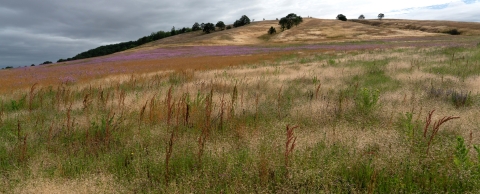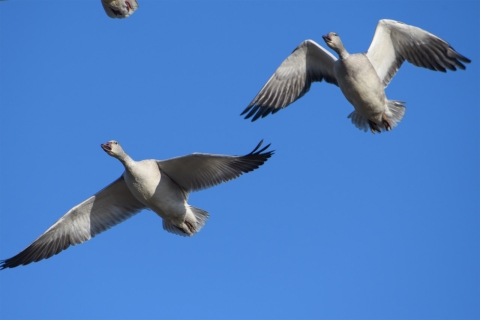Seasons of Wildlife
Baskett Slough National Wildlife Refuge was established to protect wintering habitat for dusky Canada geese, but provides for a wide variety of bird, plant, and animal species. From the black-tailed deer to the least sandpiper, Baskett Slough provides a habitat type for everyone.
Over 250 species of breeding, migrating, and resident birds have been recorded at Baskett Slough National Wildlife Refuge during the different seasons. A list of birds recorded can be found on eBird.
Roosevelt Elk, Coyote, Townsend's Chipmunk, and Brush Rabbit are among the several species of year-round residents observed during the early morning or evening hours. A partial list of species can be found on iNaturalist.
A complete list of species can be found at the bottom of this page.
Spring
Baskett Slough during the Spring is a great time to experience the variety of different species of plants and animals that reside on the Refuge. Neotropical migrating birds and migrating shorebirds stop at the Refuge to forage and rest during their journey. The numerous flocks of waterfowl from the Winter begin their migration up North as well. Resident species of waterfowl will stay at the year-round wetlands around the Refuge. The Refuge houses several species of wildflowers in the native prairie habitats that are being restored. Kincaid's Lupine, Camas, Golden Paintbrush, and Oregon Grape are just a few examples of flora found at Baskett Slough.
Summer
Adults of many species of animals raise their young during the summer season. The Willamette Valley experiences hot and dry periods during this time of the year, so it is best to visit early in the morning or before sunset to get a better chance of observing wildlife. Stop by Morgan Lake or Baskett Butte Loop trail to see Cinnamon Teals, hear the wichity of Common Yellowthroats, or Coyotes.
Fall
Fall at the Refuge means cooler weather and cool colors. Bigleaf Maple and Oregon Ash tree leaves become golden yellow and highlight the different habitats at the Refuge. The seasonal wetlands begin to fill with water attracting waterfowl such as Cackling geese, Tundra swans, dusky Canada goose, and more!
Threatened & Endangered Species
Not only home to common species, Baskett Slough National Wildlife Refuge is also called home by a number of threatened and endangered ones. Baskett Butte provides prime oak savanna habitat which, once common in the Willamette Valley, is now extremely rare. Once a habitat becomes uncommon, the plants and animals adapted to this habitat often become rare as well. Some species that rely on the upland oak savanna habitat are Fender's blue butterfly, Kincaid's lupine (shown above), Willamette daisy, and golden paintbrush.
Fender's Blue Butterfly
Endangered butterfly. Fender's blue butterfly was thought to be extinct from 1940 until the late 1980's when biologists discovered a few remaining populations in the Willamette Valley. It prefers native upland prairies with abundant flowering plants that provide food for larvae and adults. Kincaid's lupine is its primary larval host plant. The open structure of prairies is just as important to this butterfly as all the threatened and endangered prairie wildflowers. Refuge staff maintain these habitats through burns and mowing. The largest known population of this butterfly is found on Baskett Slough's Baskett Butte. Fender's blue are active as adults only a short period of their lives, spending much of their lifespan in larval and pupal stages. To catch their brief period of flight, visit Baskett Butte from mid May to early June.
Willamette Daisy
Endangered wildflower. The Willamette daisy typically occurs in upland prairie and oak savanna habitats with little to no shrub cover. These habitats require periodic disturbances that prevent the encroachment of trees and shrubs to maintain the open landscape, thus suppression of these disturbances has led to habitat loss and a decline in the daisy populations. The refuge uses prescribed fire and mowing to prevent this encroachment and boosts population numbers with supplemental plantings and the use of herbicides on non-native competitors. A significant population of this endangered flower is found in the native upland savanna of Baskett Slough.
Streaked Horned Lark
Threatened passerine. The streaked horned lark was first listed under the Endangered Species Act in 2013, and critical habitat has been designated on all three Willamette Valley Complex Refuges. The habitat favored by the lark is characterized by wide open spaces with few trees and shrubs. The designated habitat areas are managed by the Service for streaked horned lark use through reintegration of natural disturbance processes, such as fires, which prevent large shrubs from encroaching.
Kincaid's Lupine
Threatened prairie wildflower. Kincaid's lupine occurs in upland prairies and oak savanna habitats with little to no shrub cover. Habitat loss and lack of regular disturbances (which prevent the encroachment of trees and shrubs) have caused populations of the flower to dramatically decline. The protection of this plant species is not only important for its own survival, but it is a vital element in the survival of the endangered Fender's blue butterfly. Kincaid's lupine is one of Fender's blue butterfly's primary larval host plants. Refuge staff utilize prescribed fire, mowing, and herbicide treatment of non-native plants to maintain the open habitat the flower requires and supports its populations through plantings. Some Kincaid's lupine occurs on Baskett Butte, though much of it has hybridized with a closely related plant, spurred lupine. Spurred lupine and the Kincaid's-spurred hybrids also serve as host plants for Fender's blue.
Nelson's Checkermallow
Threatened wildflower. Nelson's checker-mallow typically occurs in wet prairies and floodplains of the Willamette Valley and Coast Range. Its habitat is threatened much like that of the Willamette Daisy due to the suppression and elimination of natural disturbances, resulting in the encroachment of woody vegetation. Refuge staff is working to recover this flower through supplemental plantings and habitat management techniques such as mowing and prescribed fire.
Golden Paintbrush
Threatened prairie wildflower. Golden paintbrush typically occurs in upland prairie habitats with flat or mounded topography. Completely extirpated from its historic range in Oregon by 1983, the paintbrush was reintroduced to this area through the Golden Paintbrush Recovery Plan. Biologists on Baskett Slough actively work to boost the golden paintbrush populations through supplemental plantings, prescribed burns and mowing on refuge prairies. Aside from the Willamette Valley, golden paintbrush has been found in Washington and British Columbia in the Puget Sound area. Over half of the eleven sites found there occur on Whidbey, San Juan and Lopez Islands.




